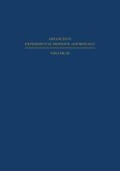Abstract
Like the molecules of other amphipathic lipids, such as phospholipids, which constitute the building blocks of biological membranes, the ganglioside molecule consists of a lipophilic part and a hydrophilic part, i. e., a ceramide and a sialo-oligosaccharide. As compared to phospholipids, the gangliosides show much more variation in their polar head group region than in their hydrocarbon chains. (Wiegandt, 1968; 1971; 1973). In recent times increasingly observations are reported that point towards the potential biological significances of the gangliosides in view of the large diversity of highly specific interactions possible for their carbohydrate residues. Thus gangliosides are implicated in the interactions of hormones (Wolley & Gommie, 1965; Mullin et al., 1976), lectins (Surola et al., 1975), viruses (Haywood, 1974) and interferon (Besancon et al., 1976). The longest known instance of a specific binding of ganglioside dates back to the observation made in 1898 by Wassermann & Takaki that brain tissue could fix tetanus toxin. This phenomenon was later shown by van Heyningen (1974) to be due to ganglioside, which may fix the toxin without however inhibiting its in vivo toxicity. More recently other bacterial toxins were found also to bind specifically to various gangliosides and it was postulated that the sialoglycolipids may actually constitute the natural cell membrane receptors for the toxins. Cholera toxin is fixed by ganglioside II3NeuAc-GgOse4-Cer (van Heyningen, 1974; Stärk, et al., 1974). Escherichia coli toxin can be prevented from entering polyacrylamide gel in electrophoresis when it is in the presence of the trisialoganglioside IV3 NeuAc-, II3 (←2αNeuAc8)2 GgOse4-Cer (Stärk, J., Sattler, J., and Wiegandt, H., unpublished observation). Recently Kato and Naiki (1976) reported that staphylococcus toxin was bound by ganglioside IV3NeuAc-LnOse4-Cer. The structure of the latter ganglioside, i. e., NeuAcα2→3Galβ1→4GlcNAcβ1→ 3Galβ1→4Glcβ1→cer (Wiegandt, 1973), is in its terminal monosaccharide residues identical to sialo-oligosaccharide moieties found frequently with glycoproteins, in particular in those of the human plasma (Kato & Naiki, 1976).
Abbreviations of gangliosides are given according to recommendations of Iupac-IUB lipid nomenclature document 1976.
Access this chapter
Tax calculation will be finalised at checkout
Purchases are for personal use only
Preview
Unable to display preview. Download preview PDF.
References
Besancon, F., Ankel, H. & Basu, S. (1976) Nature 259, 576–578.
Haywood, A. M. (1974) J. Mol. Biol. 87, 625–628.
Helting, T. B. & Zwisler, O. (1976) J. Biol. Chem. (in press).
Helting, T. B. Zwisler, O. & Wiegandt, H. (1976) J. Biol. Chem. (in press).
Hill, A. J. (1913) Biochem. J. 7, 471.
Holmgren, J., Manson, J. E. & Svennerholm, L. (1974) Med. Biol. 52, 229–233.
Kato, J. & Naiki, M. (1976) Infection and Immunity 13, 289–291.
Kimberg, D. V., Field, M., Johnson, J., Hendersson, A. & Gershon, E. (1971) Clin. Invest. 50, 1218–1230.
Mullin, B. R., Aloj, S. M., Fishman, P. H., Lee, G., Kohn, L.D. & Brady, R. O. (1976) Proc. Natl. Acad. Sci. 73, 1679–1683.
Olsnes, S., Refsnes, K. & Pihl, A. (1974) Nature 249, 627–631.
Pappenheimer, Jr. A. M. & Gill, D. M. (1973) Science 182, 353–364.
Sattler, J., Schwarzmann, G., Ziegler, W. & Wiegandt, H. (1976) Hoppe-Seyler’s Z. Physiol. Chem. submitted.
Scatchard, G. (1949) Ann. N. Y. Acad. Sci. 51, 660–672.
Schenkein, I., Green, R. F., Santos, D. S. & Maas, W. K. (1976) Infection and Immunity 13, 1710–1720.
Sharp, G. W. G.& Hynie, S. (1971) Nature 229, 266–269.
Stärk, J., Ronneberger, H. J., Wiegandt, H. & Ziegler, W. (1974) Eur. J. Biochem. 48, 103–110.
Surola, A., Bachhawat, B. K. & Padder, S. K. (1975) Nature 257, 802–804.
Swaminathan, N. & Aladjem, F. (1976) Biochemistry 15, 1516–1522.
Van Heyningen, W. E. (1974) Nature 249, 415–417.
Van Heyningen, W. E. & Miller, P. (1961) J. Gen. Microbiol. 24, 107–119.
Vassermann, A. & Takaki, T. (1898) Berl. Klin, Wschr. 35, 5.
Wiegandt, H. (1968) Ang. Chem. Int. Edt. 7, 87–96.
Wiegandt, H. (1971) Adv. Lipid Res. 9, 249–289.
Wiegandt, H. (1973) Hoppe-Seyler’s Z. Physiol. Chem. 354, 1049–1056.
Wiegandt, H. & Ziegler, W. (1974) Hoppe-Seyler’ s Z. Physiol. Chem, 355, 11–18
Wiegandt, H. Ziegler, W., Staerk, J., Krans, Th., Ronneberger, H. J., Zilg, H., Karlsson, K. A. & Samuelsson, B. E. (1976) Hoppe-Seyler’s Z. Physiol. Chem. (in press)
Wolley, D. W. & Gommie, B. W. (1965) Proc. Natl. Acad. Sci. 53, 959–963.
Author information
Authors and Affiliations
Editor information
Editors and Affiliations
Rights and permissions
Copyright information
© 1977 Plenum Press, New York
About this chapter
Cite this chapter
Wiegandt, H. (1977). Structural Specificity of Gangliosides. In: Bazán, N.G., Brenner, R.R., Giusto, N.M. (eds) Function and Biosynthesis of Lipids. Advances in Experimental Medicine and Biology, vol 83. Springer, Boston, MA. https://doi.org/10.1007/978-1-4684-3276-3_24
Download citation
DOI: https://doi.org/10.1007/978-1-4684-3276-3_24
Publisher Name: Springer, Boston, MA
Print ISBN: 978-1-4684-3278-7
Online ISBN: 978-1-4684-3276-3
eBook Packages: Springer Book Archive

